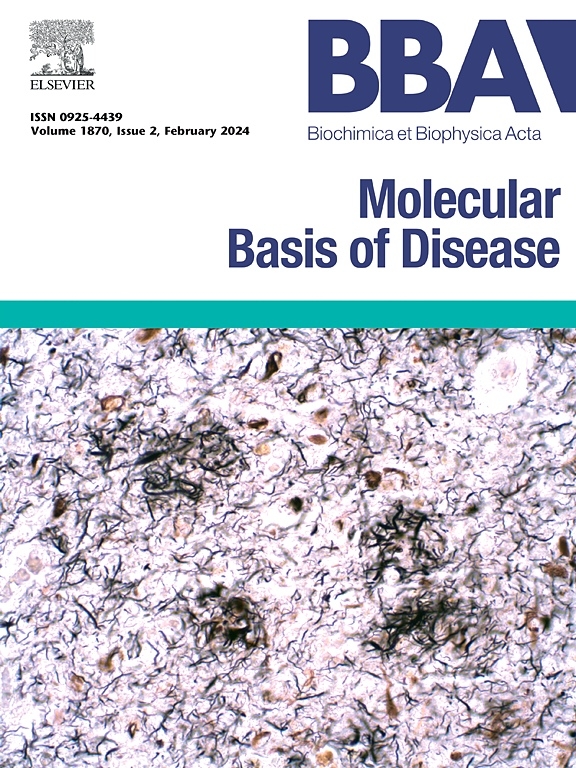Hepcidin/HIF-1α is involved in the endogenous recovery and ferroptosis after cerebral ischemia in mice
IF 4.2
2区 生物学
Q2 BIOCHEMISTRY & MOLECULAR BIOLOGY
Biochimica et biophysica acta. Molecular basis of disease
Pub Date : 2025-08-16
DOI:10.1016/j.bbadis.2025.168022
引用次数: 0
Abstract
It is common to witness a spontaneous endogenous recovery process with the potential mechanisms involving the remyelination, nerve regeneration, and synaptic plasticity, which might be vital for the neurological rehabilitation after cerebral ischemic stroke. Iron homeostasis is considered to be crucial for myelination and neuronal metabolic processes, and Hepcidin is an important factor in regulating iron homeostasis and ferroptosis. Hypoxia-inducible factor (HIF) is an important hypoxia tolerance factor and can regulate cell survival in hypoxia environment, which is critical to regulate iron homeostasis as well. Nevertheless, the effect of Hepcidin on endogenous injury repair during cerebral ischemia recovery period and whether Hepcidin could regulate ferroptosis via HIF-1α remain unclear. Here, we established the distal middle cerebral artery occlusion (dMCAO) mice model to investigate the effect of Hepcidin on endogenous injury repair and ferroptosis during cerebral ischemia recovery and HIF-1α-associated mechanisms. Our results indicated that Hepcidin/HIF-1α pathway played a crucial role in regulating ferroptosis as well as endogenous injury repair and subsequent neurological recovery after cerebral ischemia, serving as a possible target for the treatment of recovery after stroke.
Hepcidin/HIF-1α参与小鼠脑缺血后内源性恢复和铁凋亡
脑缺血后神经系统的自发内源性恢复过程是常见的,其机制可能涉及髓鞘再生、神经再生和突触可塑性,这可能对脑缺血后神经系统的康复至关重要。铁稳态被认为对髓鞘形成和神经元代谢过程至关重要,而Hepcidin是调节铁稳态和铁凋亡的重要因子。缺氧诱导因子(hypoxia inducible factor, HIF)是一种重要的缺氧耐受因子,可以调节细胞在缺氧环境下的存活,对铁稳态的调节也至关重要。然而,Hepcidin对脑缺血恢复期内源性损伤修复的影响以及Hepcidin是否通过HIF-1α调控铁凋亡的作用尚不清楚。本实验建立大脑远中动脉闭塞(dMCAO)小鼠模型,探讨Hepcidin对脑缺血恢复过程中内源性损伤修复和铁上坠的影响及hif -1α相关机制。我们的研究结果表明,Hepcidin/HIF-1α通路在脑缺血后铁凋亡、内源性损伤修复和随后的神经系统恢复中起着至关重要的调节作用,可能是脑卒中后恢复治疗的靶点。
本文章由计算机程序翻译,如有差异,请以英文原文为准。
求助全文
约1分钟内获得全文
求助全文
来源期刊
CiteScore
12.30
自引率
0.00%
发文量
218
审稿时长
32 days
期刊介绍:
BBA Molecular Basis of Disease addresses the biochemistry and molecular genetics of disease processes and models of human disease. This journal covers aspects of aging, cancer, metabolic-, neurological-, and immunological-based disease. Manuscripts focused on using animal models to elucidate biochemical and mechanistic insight in each of these conditions, are particularly encouraged. Manuscripts should emphasize the underlying mechanisms of disease pathways and provide novel contributions to the understanding and/or treatment of these disorders. Highly descriptive and method development submissions may be declined without full review. The submission of uninvited reviews to BBA - Molecular Basis of Disease is strongly discouraged, and any such uninvited review should be accompanied by a coverletter outlining the compelling reasons why the review should be considered.

 求助内容:
求助内容: 应助结果提醒方式:
应助结果提醒方式:


